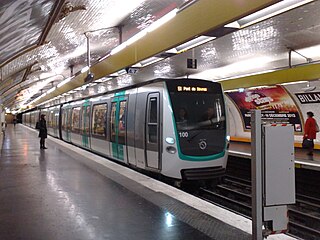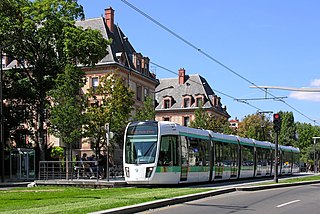
Quai de la Rapée is a station of the Paris Métro, serving Line 5, located in the 12th arrondissement of Paris.

Balard is the southwestern terminus of Line 8 of the Paris Métro in the 15th arrondissement of Paris. Since 16 December 2006, it has also been a stop on tramway T3a as part of the initial section of the line between Pont du Garigliano and Porte d'Ivry. The station is named after Place Balard, itself named after Antoine-Jérôme Balard (1802-1876), a French chemist and the discoverer of bromine. Among the stations serving the Boulevards des Maréchaux along the former gates of Paris, it is the only one not called Porte de…, though it serves the Porte de Sèvres.

Paris Métro Line 9 is one of 16 lines of the Paris Métro. The line links Pont de Sèvres in Boulogne in the west with Mairie de Montreuil in the east via the city center of Paris, creating a parabola type shape to its route. It is the third busiest line on the network.

The RATP bus network covers the entire territory of the city of Paris and the vast majority of its near suburbs. Operated by the Régie Autonome des Transports Parisiens (RATP), this constitutes a dense bus network complementary to other public transport networks, all organized and financed by Île-de-France Mobilités.

The Île-de-France tramways is a network of modern tram lines in the Île-de-France region of France. Fourteen lines are currently operational, with extensions and additional lines in both construction and planning stages. Although the system mainly runs in the suburban regions of Paris, lines T3a and T3b run entirely within Paris city limits, while lines T2 and T9 start their routes within Paris' borders. While lines operate independently of each other and are generally unconnected, some connections do exist: between lines T2 and T3a, T3a and T3b, T1 and T5, T1 and T8, T8 and T11 Express, T3a and T9 and T6 and T10. However, the final design of the entire planned tram network is fairly integrated.

The Pont de Bir-Hakeim, formerly the Pont de Passy, is an arch bridge that crosses the Seine in Paris. It connects the 15th and 16th arrondissement, passing through the Île aux Cygnes. The bridge, made of steel, was constructed between 1903 and 1905, in replacement of a footbridge that had been erected in 1878. The bridge has two levels: one for motor vehicles and pedestrians, the other being a viaduct built above the first one, through which passes Line 6 of the Paris Métro. The bridge is 237 metres (777 ft) long and 24.7 metres (81 ft) wide. The part crossing the Grand Bras of the Seine is slightly longer than the one crossing the Petit Bras.

Île-de-France tramway lines 3a and 3b are the first modern tramway in Paris proper since the 1937 closure of the previous comparable system. They are operated by the RATP and divided into two sections called T3a and T3b. The line is also known as the Tramway des Maréchaux because it follows the Boulevards of the Marshals, a series of boulevards that encircle Paris along the route of the former Thiers Wall. The boulevards are, with three exceptions, named for Napoleon's First Empire marshals (maréchaux); they were transformed by redevelopment works carried out during the two-and-a-half-year construction of the line, which opened on 16 December 2006 under the designation T3.

Viaduc d'Austerlitz is a single-deck, steel arch, rail bridge that crosses the Seine in Paris. Its usage is dedicated solely to Line 5 of the Paris Métro. It links Gare d'Austerlitz on the Rive Gauche to Quai de la Rapée on the other side of the river.

The Pont Charles-de-Gaulle is a steel-reinforced concrete girder bridge straddling the river Seine in the eastern part of Paris. It is a one-way bridge carrying road traffic from the 13th arrondissement to the 12th arrondissement. Another one-way bridge further downstream, Pont d'Austerlitz, carries traffic in the opposite direction.

The Passerelle Simone-de-Beauvoir is a bridge solely for pedestrians and cyclists across the Seine River in Paris. It is the 37th bridge on the Seine in Paris. It is located between the bridges of Pont de Bercy and Pont de Tolbiac and links up the 12th and 13th arrondissements of Paris. Its nearest Paris Metro station is Quai de la Gare.

The Chemin de fer des Côtes-du-Nord, the Côtes-d'Armor today, was a 1,000 mm, metre gauge, railway in Côtes-du-Nord, France, although there were a few kilometres of line in Finistère and Ille-et-Vilaine. The first lines opened in 1905 and final closure was in 1956. The lines were a voie ferrée d'intérêt local system with a total extent of 457 kilometres (284 mi).

The Boulevards of the Marshals are a collection of thoroughfares that encircle the city of Paris, France, just inside its city limits. Most bear the name of a marshal of the First French Empire (1804–1814) who served under Napoleon I. The Île-de-France tramway Lines 3a and 3b today run on the Boulevards of the Marshals.

Pont du Garigliano station is a station on the RER C line of the Paris Region's express suburban rail system, the Réseau Express Régional (RER) and Line 3a of the Île-de-France tramway network. The station is named for the nearby Pont du Garigliano and Hôpital Européen Georges-Pompidou

Paul Séjourné was a French engineer who specialized in the construction of large bridges from masonry, a domain in which he made some important innovations.
This article presents the main landmarks in the city of Paris within administrative limits, divided by its 20 arrondissements. Landmarks located in the suburbs of Paris, outside of its administrative limits, while within the metropolitan area are not included in this article.

The architecture of Paris created during the Belle Époque, between 1871 and the beginning of the First World War in 1914, was notable for its variety of different styles, from neo-Byzantine and neo-Gothic to classicism, Art Nouveau and Art Deco. It was also known for its lavish decoration and its imaginative use of both new and traditional materials, including iron, plate glass, colored tile and reinforced concrete. Notable buildings and structures of the period include the Eiffel Tower, the Grand Palais, the Théâtre des Champs-Élysées, the Gare de Lyon, the Bon Marché department store, and the entries of the stations of the Paris Metro designed by Hector Guimard.

The Boulevard du Général-d'Armée-Jean-Simon is a boulevard in the 13th arrondissement of Paris, France. It is one of the Boulevards of the Marshals, which run in the outer parts of the city.

The Charenton Metro-Viaduct is a railroad girder bridge located in the French department of Val-de-Marne in the Île-de-France region. It links the communes of Charenton-le-Pont and Maisons-Alfort, crossing the Marne river, as well as the A4 autoroute and 103 departmental road. First put into operation in 1970, the viaduct is used by trains on line 8 of the Paris metro.



















